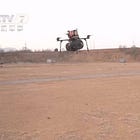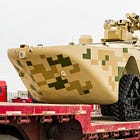In several recent posts, I highlighted some of the approaches through which the People’s Liberation Army (PLA) can employ armed multirotor drones, including those of the so-called “first-person video” (“FPV”) variety as well as conceptually similar fixed-wing designs, to attack a wide range of targets on the island of Taiwan in the manner that these uncrewed aircraft-turned-strike munitions are employed on a massive scale in the Russia-Ukraine War. China can use various strike munitions, including armed “FPV” drones launched from aerial “motherships and/or uncrewed surface vessels (USVs) serving as motherships, to attack Taiwanese military vehicles located on Taiwan’s western coastal plain, which typically extends over a depth of just 25-35 kilometers.


One of the many challenges that Taiwan faces is that most of its military vehicles are, at best, lightly armoured, and are wholly exposed to the all-aspect shaped charge threat brought about by the introduction of truly mass-produced inexpensive armed “FPV” multirotor drones using commercial off the shelf (COTS) components, many of which are primarily sourced from Chinese manufacturers. The above images, which are from the Taiwanese army’s latest and ongoing exercises, exemplify this dynamic as neither the TOW anti-tank missile-equipped HMMWV nor the CM-11 tank are survivable in the face of the all-aspect shape charge threat. Only the Taiwanese army’s new American-built M1 tanks can withstand multiple hits from armed “FPV” multirotor drones, and even those vehicles require significant add-on armour, given the vulnerabilities of armour on the roof and above the engine compartment.
The fact that the vast majority of Taiwanese ground forces will not step foot outside the island of Taiwan allows the Taiwanese military to up-armour its existing vehicles along the lines of how Russia and Ukraine have done and continue to do with varying levels of effectiveness. As the above images from the latest and ongoing exercises make clear, however, the Taiwanese military does not appear to have begun to install fairly simple and inexpensive add-on armour on its vehicles, at least not at an appreciable scale. It bears emphasis that the armed "FPV” multirotor drone threat to Taiwan is not simply a matter of the forward launch of such uncrewed aircraft-turned-strike munitions from airborne or seaborne “motherships”—PLA units undertaking an amphibious assault and/or an air assault will arrive on the island of Taiwan equipped with such armaments.
Some relevant posts:




